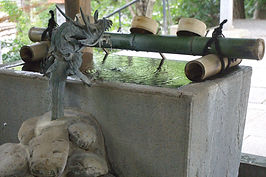普通の外にいくつかの著名な品質を持っている、と畏敬の念を起こさせるあるいかなるビーイングは、カミと呼ばれています。
Nearest station
Yaho
JR Nambu Line
Tōkyō-to, Kunitachi-shi, Yaho 5208
東京都国立市谷保5208
谷保天満宮
Yaho Tenman-gū
Home page: (Japanese)
July 30, 2017
History
The origin of the shrine dates back to 903, the year Sugawara Michizane died. When Michizane had earlier been exiled to Kyūshū his third son, Michitake, had been banished to what is now Yaho in Kunitachi-shi. When his father died Michitake carved a statue of him and enshrined it in a jinja, Saburō-den, at a place then known as Tenjin-shima close to the shrine's current site. In 947, when the Kitano Tenman-gū was being built in Kyōto, Emperor Murakami decreed that a new main hall be built at the Tenjin-shima shrine and that it be designated a Kansha. In 1181, a descendant of Michitake, Tsunoto Saburō Tamemori, moved the shrine to its current location, possibly in response to a vision. Sometime during the Edo Period the shrine was awarded a stipend equivalent to 13.5 koku of rice (one koku was considered sufficient to feed one man for one year). In 1885 it was given a Fusha ranking.
Description
About 200 meters from Yaho Station, Yaho Tenman-gū is one the Top 3 Kantō Tenjin (Kantō Daisan Tenjin, 関東三大天神),
Enshrined Deities:
Main
Sugawara no Michitake 菅原道武
From Merged Shrines
Iwatsuchi-biko-kami (17A) 石土毘古神
Ameno-hiwashi-mikoto 天之日鷲命
Ukano-mitama-mikoto 倉稲魂命
In-ground Shrines:
Dairokuten Jinja 第六天神社
Inari Jinja 稲荷神社
Shinmei Sha 神明社
Earliest mention of: 903
Annual Festival: Sept. 23-25


along with Kameido Tenjin and Yushima Tenjin. It is by far the oldest of the three, pre-dating Kameido by about seven centuries, and Yushima by a mere four centuries or so. It is, though, by far the least well-known of the three and I assume that this is because it is in the Tōkyō suburbs rather than the city proper. That said, it is well worth visiting. The shrine grounds are extensive and away from the shrine buildings shade into parkland. This being a Tenman-Gū there are of course nade-ushi on display, "are" not "is" because there are actually two of them bemoaning the passage of the master. Again befitting a Tenman-Gū, there are some 350 or so plum trees scattered around the grounds, although I have not been able to determine whether or not there are any Tobiume (flying plum tree) amongst them. I suspect not. A plum festival is held on the last weekend of February.
(Click on images to expand them)
































